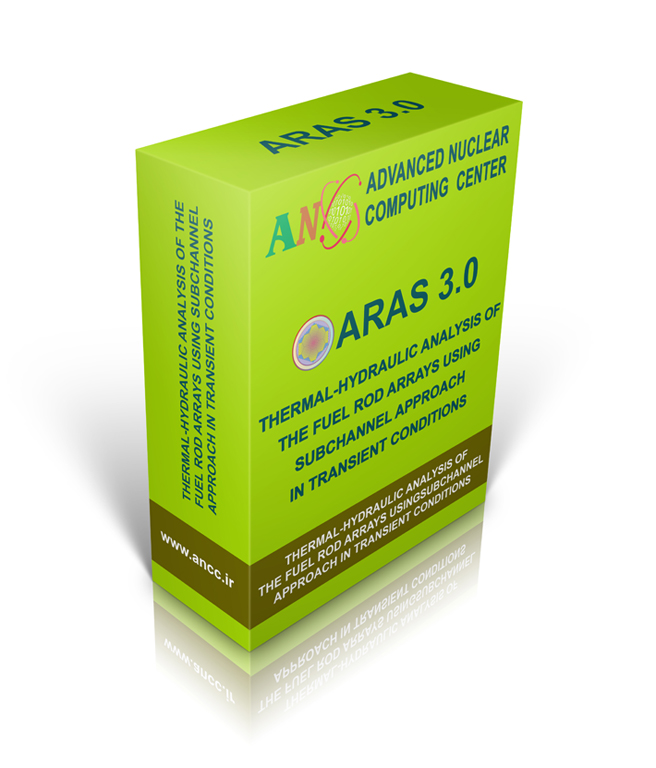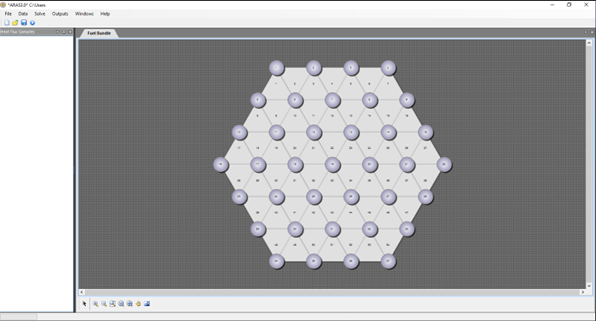
ARAS3.0
Thermohydraulic Code to Analyze the Core and Fuel assemblies of Light Water Reactors using Subchannel Approach
INTRODUCTION
The core of a nuclear reactor can be considered as the most important component as its main roles. Reactor core analysis can affect the safety limitations of different components of nuclear reactors. In the case of core study, the thermal-hydraulic simulation plays an important role. For this purpose, ARAS3.0 computing software has been developed in I. R. Iran’s Advanced Nuclear Computing Center (ANCC). ARAS3.0 is the latest version of ARAS software class for thermal-hydraulic transient analysis of fuel assemblies and reactor cores. ARAS3.0 is a thermal-hydraulic code, using subchannel approach with the homogeneous equilibrium model, which is equipped with a graphical user interface. Using ARAS3.0 software, hexagonal and rectangular geometries can be analyzed.

The entire system has been verified using various benchmarks and reference data found in published reports, as well as, comparisons made mainly against COBRA-EN code outputs and CFD analysis results. Excellent agreements found in almost all cases which bring a meaningful trust for the users. Yet, V&V is still going on for more certitude.
METHODOLOGY
The thermal-hydraulic homogeneous model of ARAS3.0 that is known as "subchannel approximation", is based on COBRA-EN code formulation. In order to model the behavior of the fluid, the three main conservation equations of mass, energy and momentum are discretized in the desired computational space and after determining other auxiliary parameters for a problem, they are solved by a sequence method. This code uses the pressure gradient method to solve the transverse momentum equation. Therefore, there is no possibility of modeling reverse flows.
The code allows to simulate the thermal-hydraulic transient response to user-supplied changes of the total power, ,outlet pressure, inlet temperature and mass flux.
ARAS3.0 was also improved with some correlations. The correlations for vapor generation and slip ratio has been added for extend the capabilities of the essentially homogeneous three-equation model. The models has been used in the software are listed as follow:
|
parameters |
Models and methods |
|
Single-Phase Pressure Drop Correlation |
EPRI |
|
Single phase heat transfer coefficient |
Dittus-Boelter |
|
two phase heat transfer coefficient |
Thom |
|
Subcooled Boiling Model |
Levy |
|
Two-Phase Friction Multiplier |
EPRI |
|
void/quality relationship |
Zuber-Findlay correlation |
|
slip ratio correlation |
Smith |
|
Properties of Water |
IF97 |
|
Critical Heat Flux (CHF) |
EPRI Correlation, look-up table for custom version |
|
Gap Conduction model |
Calza-Bini or constant value |
|
Fuel and clad thermal conductivity and specific heat |
MATPRO correlations |
FEATURES
Followings are the major capabilities of ARAS3.0:
- Steady-state and transient thermal-hydraulic analysis of the fuel rod arrays and LWR cores.
- Automatic generation of subchannel geometry and the ability to consider a variety of geometries.
- Transient modes, including inlet flow and temperature, power and outlet pressure.
- Heat transfer modeling of the fuel rods with or without the central hole.
- Modeling the constant or variable gap heat transfer coefficient in terms of gas mole.
- Modeling of two types of fuel rod array, including triangular and square lattice.
- Two phase homogeneous model and considering the slip ratio, and,
- User-friendly interface and graphical output display.
APPLICATIONS
ARAS3.0 code allows two types of analysis to be performed, i.e., the "subchannel analysis” and the "core analysis". In the first case, the area between the fuel rods is considered as a subchannel, and in the second case, each fuel assembly is considered as a subchannel. This software covers a wide range of issues in thermohydraulic analysis of light water reactor cores. The definition of the input parameters can be performed includes coolant thermal-hydraulic properties, fuel rod component temperature, critical heat flux and crossflow between subchannels.



